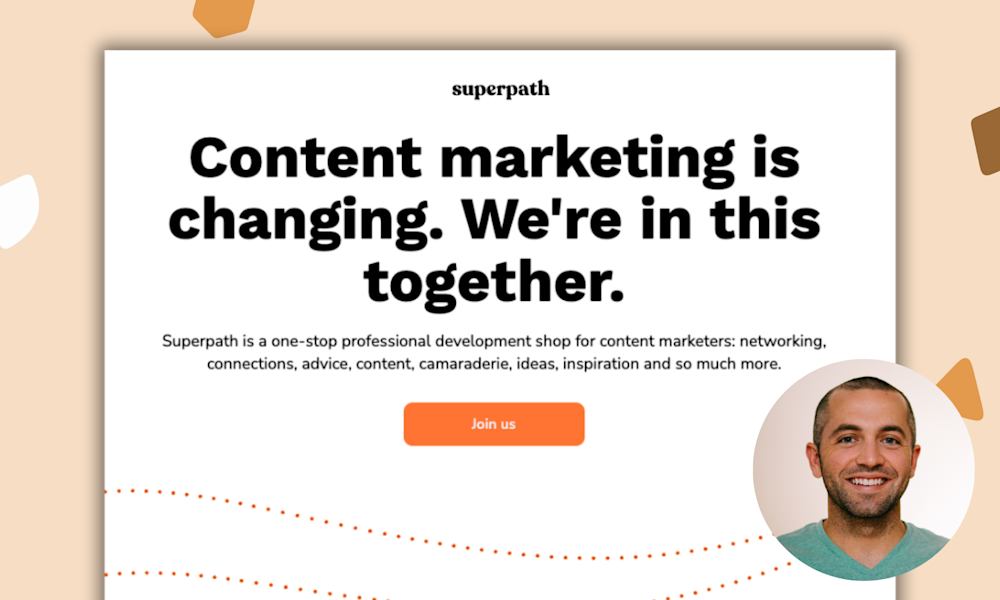On the first day of class, creativity and innovation professor Juan Muñoz told his students they could turn in their homework any way they wanted.
“It can be written down, it can be in your own handwriting, it can be typed on the computer, it can be a video, it can be a podcast–you can do whatever you want to do. If you want to send a messenger dove with your homework, that’s fine. You don’t have to be confined by a piece of paper or Google Doc,” he instructed.
But even with this freedom, his university students still turned in identical PDFs with the same formatting every single time.
“I was so frustrated,” Juan remembers. “I thought this was the simplest task in the world. How are they going to learn creativity if they can’t even get this done?”
As the pattern continued, Juan wondered if there was a bigger issue at play.
“Students have been programmed for ten, fifteen years in school. They’ve been taught that, whether you’re great or not great, you’ll get a worse grade if you deviate from whatever template that teacher gave you. There’s an intrinsic fear of deviating from the standard path.”
Juan could see that this internalized programming was hurting creativity, and he wanted to change things.
Juan loved teaching, but he felt constricted by university rules. In his free time, he read TechCrunch and other entrepreneurial publications, which gave him the idea to start a business.
At the time, there wasn’t an active entrepreneurship ecosystem in Juan’s home country of Costa Rica, so Juan decided to help get the ball rolling.
“I have a civil engineering degree, and I knew people would think, ‘What does this guy know about business?’ So the first thing I did was I wrote all of my ideas down in a blog and spread them around. I launched my creator career by sharing my ideas online and sharing the things I can do.”
Today, Juan teaches creativity, goal-setting, entrepreneurship, and business through his online learning platform, Épico Academia. He offers online courses, a library of free workshops, and a paid weekly email newsletter to help people live more creative and epic lives.
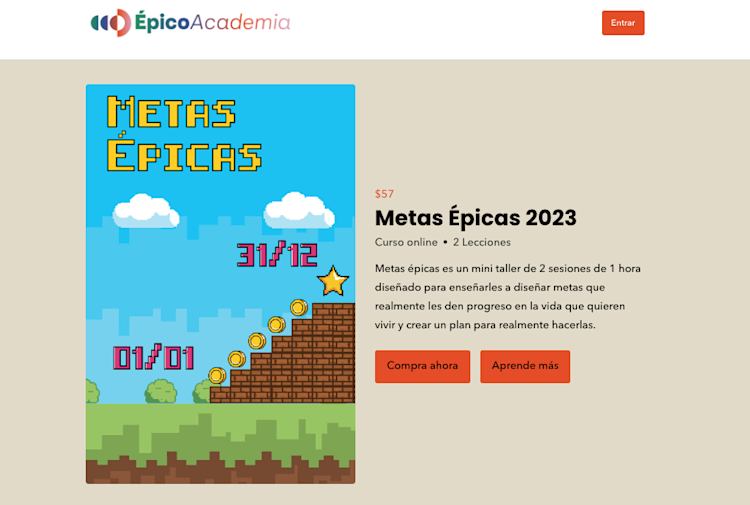
Here’s how experimenting, taking unexpected paths, and continually learning helped Juan build a thriving online business and unlock a holistic approach to entrepreneurship that’s fulfilling and fun.
How to provide content in a way that doesn’t feel like school
With his experience creating courses as a university professor, making content wasn’t a challenge for Juan. He just had to figure out the most impactful way to deliver that content.
“The biggest friction is getting people to consume the content we make,” Juan shares.
“People will buy a course and only a handful will go through it. It feels like school. Even if nobody’s making me do it and I’m really interested, my brain goes back to school mode. There’s a teacher, there are modules, there are classes.”
So Juan started experimenting with other ways he could get his content to his audience.
“What if I try an email-based course where you receive a cool email every week for a year? Or TikTok-type content, just 30-second videos. Can I create a course with tons of 30-second videos? I don’t know, maybe. I’ll try it out and see if it works.”
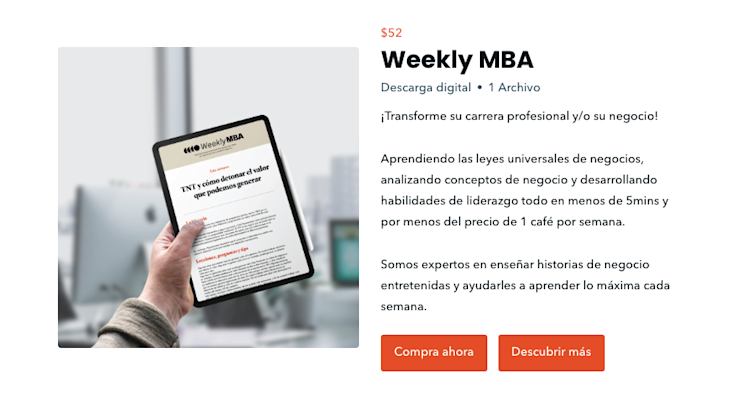
Having the right technology in your corner can make experimenting with different delivery methods and content formats easier. Before, Juan used Gumroad to sell his products, but he felt limited because the platform was mainly for PDFs and files.
When he switched to Podia, Juan gained access to a wide variety of product types so he could test out different formats and make his lessons more exciting.
“I love how Podia allows me to do basically whatever content I want in whatever order I want. I can make a course that’s just 100, 30-second videos and have people go through them.”
Podia is an all-in-one platform that makes it easy to sell online courses, digital downloads, community, coaching, and webinars about the topics you love. You can also manage your email marketing, affiliates, and website from one streamlined dashboard. If you have a lot of ideas, Podia can make them happen. Register for free today.
One experiment that paid off was a pro-Monday email newsletter
Speaking of experimenting, when Juan tried something different that went against the norm, he ended up creating one of his favorite assets: The Monday newsletter.
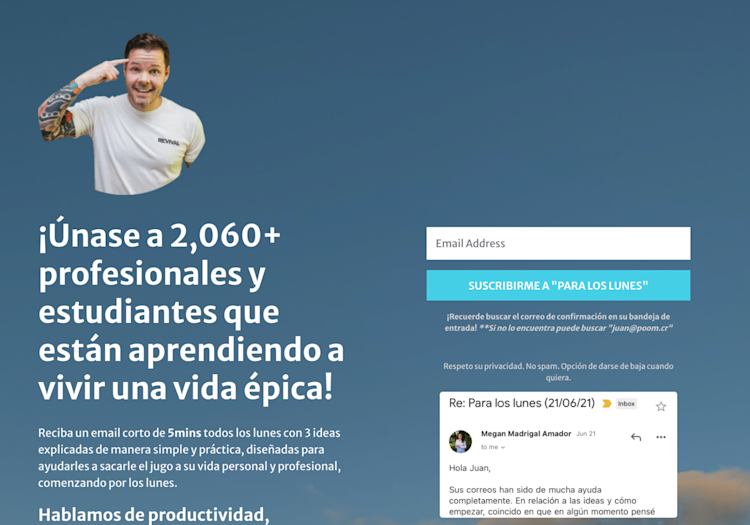
In the early days of his online business, Juan noticed a trend.
“Every Sunday night and Monday morning, people would post memes about how much they hate Mondays,” Juan says. “I thought, there’s always going to be a Monday. You can’t escape it. So why are you still hung up on this?”
“I started realizing these are the same people that come to me and say, ‘I don’t like my life, I don’t like my job, I want to get better,’ and there was a pattern. I love marketing and branding, and I thought this would be an interesting brand idea because it’s easy to hate Monday. There’s already a club for that, and it’s a big club. But how do you do the opposite?”
Juan started a newsletter all about how much he loved Mondays where he shared one tip, concept, or idea that would help his readers make the most out of their day.
“It attracted a lot of people because people were unhappy with something in their life and I was talking about ways to make their life better. It made people question, ‘Why do I hate Monday?’”
Juan published his Monday newsletter for 162 straight weeks and the consistency compounded his follower count and impact. He took a break when his daughter was born, then brought the newsletter back when he had more time during lockdowns.
Today, this experiment-turned-newsletter continues to grow through word-of-mouth referrals, and Juan still loves writing it every week.
To become a better creator, learn as much information as you can about the topics you’re interested in
Not every idea comes together as seamlessly as the Monday newsletter, and Juan found that the best way to get clarity on product and content ideas was to become a student again.
“I’m always mind blown about the fact that we get to live in a world where we can learn from anyone and anyone can learn from us. It’s amazing. If I’m into marbles, I can find someone that’s so much more into marbles that they’ll teach me new things. They can be in Singapore, I might not even know their name, but I can learn from their content.”
To become a successful creator today, learn as much as you can about the topics you love.
“I urge people to consume whatever they’re curious about,” Juan recommends. “Often you can even find free content on social media. And when you consume content, you realize, this is not that deep. This guy is talking about marbles. You don’t have to have a Ph.D. in a subject.”
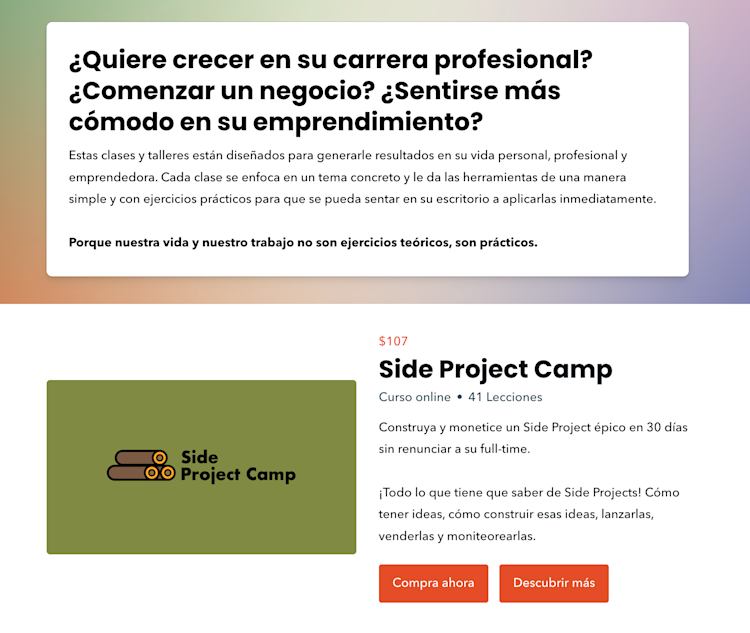
“There used to be experts,” Juan explains. “There were people that knew everything about one subject because there was only a limited amount of information available. There wasn’t infinite information like we have today, and that information was sequestered somewhere. So there was someone who knew everything about it, and they were the expert. But that’s not the case anymore.”
“There are a lot of people that know a lot, and there are a lot of people that know a little, but there’s always someone that knows less than you. So you can make content for them and still have a big impact.”
Simply put, the more you get out there and learn, the more knowledge you’ll have to share with people around you. If you’re feeling stuck on what or how to teach, try switching roles and becoming a student again to reignite your inspiration.
What if you created things just for the sake of creating them?
One of the most profound lessons Juan learned in his entrepreneurial journey is that there are many different routes people can take to share their passions.
Juan says, “We have these preconceived notions about how things should work. We look online and see how other creators are running their businesses and think that’s exactly how we should run ours too. Instead, get inspired by what others are doing and pick and choose things that work for you. If you go to Podia’s website, there are dozens of creator profiles. Read these profiles and you’ll see that there are so many different ways you can do this.”
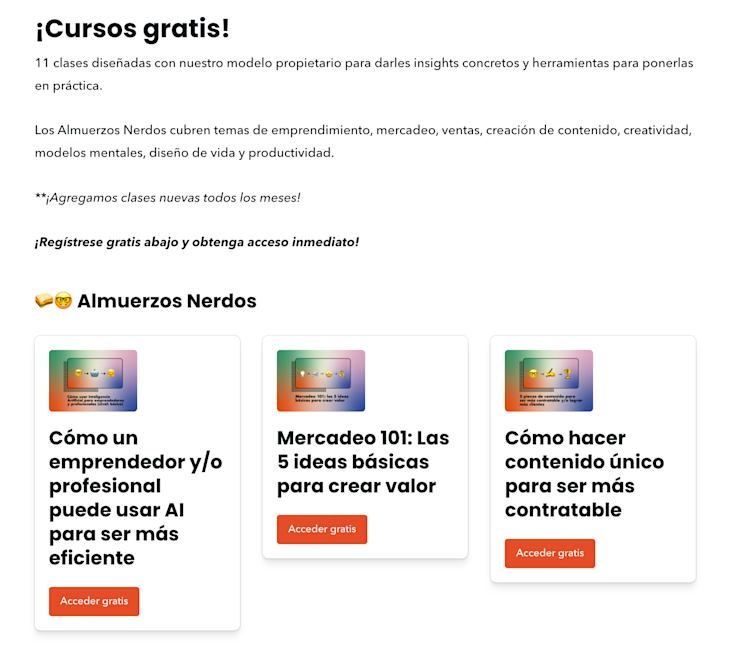
Creating also shouldn’t be all about reaching a particular outcome, financial milestone, or follower count. Instead, find a balance between Telic and Atelic goals.
“Telic goals are things that have a very fixed outcome that you can measure. Atelic goals are good to do for the sake of doing them. I think people should approach creating with both types of goals in mind,” Juan shares.
“Sure, it would be great to get a million dollars a year out of your course, but if that doesn’t happen, just having created the course is good in and of itself. There’s growth aside from the money. Building an audience is the same way. If you only focus on the number of subscribers and followers, it’ll be frustrating. But if you focus on creating excellent content every day, just doing that is beneficial to you and to that audience,” Juan reminds.
“If you’re actually helping other people out, then it doesn’t matter if it’s one person or a million.”
Plus, there’s value in your work simply existing in the world.
“If you send out a tweet, Instagram post, or video and nobody sees it, it’s still there. Someone can find it eventually. Also, getting likes on a post and helping people through your post are two very different things. I enjoy a lot of things that I don’t double-tap. Just because nobody double-tapped your post or retweeted your tweet doesn’t mean it wasn’t beneficial.”

“Creating is a visceral thing. It’s emotion, it’s vulnerable, it’s very honest,” Juan relates. “It’s a picture of who you are and what you think, and putting that out there and having no one engage with it is horrible.”
“But even if nobody buys it, it’s still valuable. You still learned a lot. You can use that knowledge in consulting or your next job or anywhere. Nobody can take that away from you. That’s soul bound.”
To stay in touch with what really matters, Juan explains how important it is to remember where you came from and celebrate everything you’ve achieved so far.
“I recommend that creators keep journals and think about what you’re doing now through the eyes of yourself five years ago, or ten years ago, or twenty years ago. Ask yourself what you would think about your work now. Because past you would probably think it’s great.”
Finally, Juan reminds creators that the most important thing is getting your work out there. It isn’t about getting record-breaking sales, likes, or clients.
“I think it’s arrogant to assume people won’t want your product. It’s arrogant because you’re making a decision for someone else. Let them make the decision. If they want it, they’ll buy it. If they don’t, they won’t. You just have to make it available to them. Be more mind-blown by the world, learn as much as you can, and make things–other people will make their own decisions.”
“Create your thing and put it out there, Juan says. “You never know what will happen next.”
